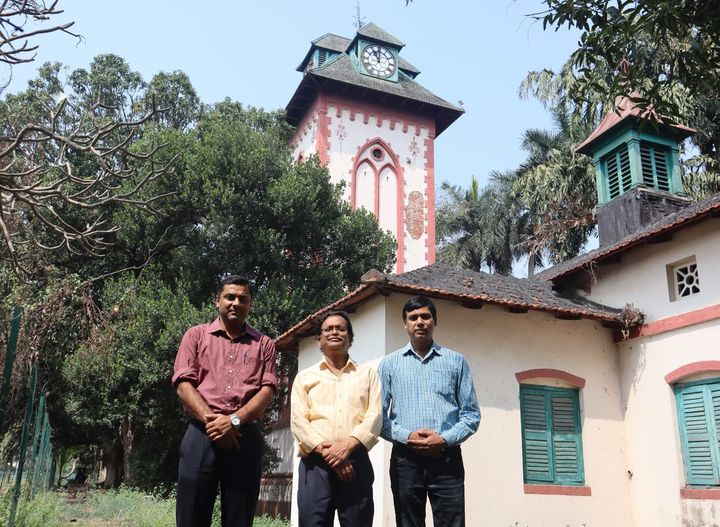

.jpg)
The century-old iconic and legendary clock tower of 175 years old campus of Indian Institute of Engineering Science and Technology (IIEST), Shibpur (formerly B. E College and BESU) has started tick-tocking again after a long non-operational period. A mechanical clock of this size and precision requires regular attention regarding mechanical up-keeping and fine adjustment. A team consisting of Prof. Subhas Chandra Mondal (Professor and Head), Dr. Apurba Das (Assistant Professor), and Dr. Rajib Chakraborty (Assistant Professor) from the Mechanical Engineering Department came forward to take up this challenge of bringing the prestigious clock tower on track under the direction of honorable director Prof. Parthasarathi Chakrabarti and ultimately able to get the clock tower on track from mid-February onwards.
Looking back at history, Sir R N Mookerjee, a distinguished alumnus of this college (1883 Civil Engg. Batch), had presented this turret clock to his alma mater, and it was installed at a five-story high tower. The clock was made by Gillett and Johnston, Croydon, England in 1919. The only other Gillett and Johnston clock in the city is the one at the clock tower of New Market, Kolkata. Gillett and Johnston were commissioned by King George V in 1844 as Bell Founders and Tower Clock Makers in Croydon, England, and they made clocks for various important locations within the colony. Apart from the two clocks in Kolkata, there are two more in Mumbai and Chennai.
The IIEST clock tower can be considered one of the engineering marvels in its category and a priceless piece of mechanical engineering equipment. Its uniqueness lies in its escapement wheel that makes it possible for the movements to work with the high-precision spur gear, bevel gear, Paul-ratchet, and cam mechanism. It needs exact synchronization among its 120 gigantic parts to function properly and run in exact time. The giant clock on the campus has a massive bell, manually operated movements with gravity loading, an Invar pendulum four faces complete with clock gradations, and arms in the four directions.
The operating mechanism kept exactly the same passion, as it was installed over 100 years ago to keep it moving. It needs a lot of care and precise adjustment otherwise accuracy may be affected and soon the movements will come to a halt. So the division wheel, division pulling that pulled the rope to run the pendulum, cams, bushes, and pivots are all restored to their original condition through careful and precise adjustment. As a positive outcome of the whole effort, the clock started operating again, showing the time restlessly from midFebruary 2024. The cast iron frames are rigid and accurately drilled to give correct gearing depths and the mechanism is accessible for inspection, oiling, and wiping. The bushes are made of gun metal, accurately reamed, and screwed. The spindle and other parts are tuned and necessary overhauling was accomplished without dismantling the clock mechanism. The clock weights are hung in one corner and the flexible steel cables supporting them pass over pulleys to the winding barrel on each train of wheels.
It was not easy to reach the gigantic movements, and faculties had to scale rickety ladders on a steep incline to reach the top of the tower for inspection and fixing the problem in awkward position. The iconic clock of IIEST is unique, and these clocks are not made anymore. The only manufacturer of Croydon-based British company Gillett and Johnston has now closed for over 65 years. Therefore, support for adjustment and maintenance from the original manufacturer is also restricted. Under these circumstances, the team from Mechanical Engineering Department will look after the upkeep and maintenance of the clock tower henceforth.
